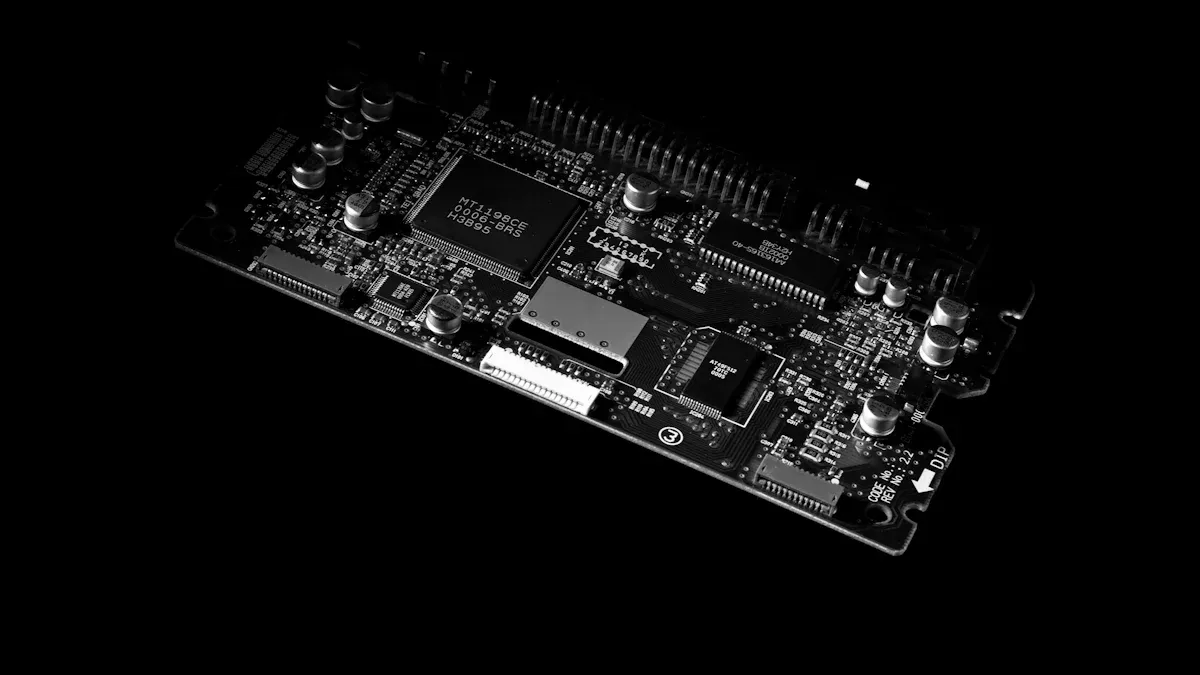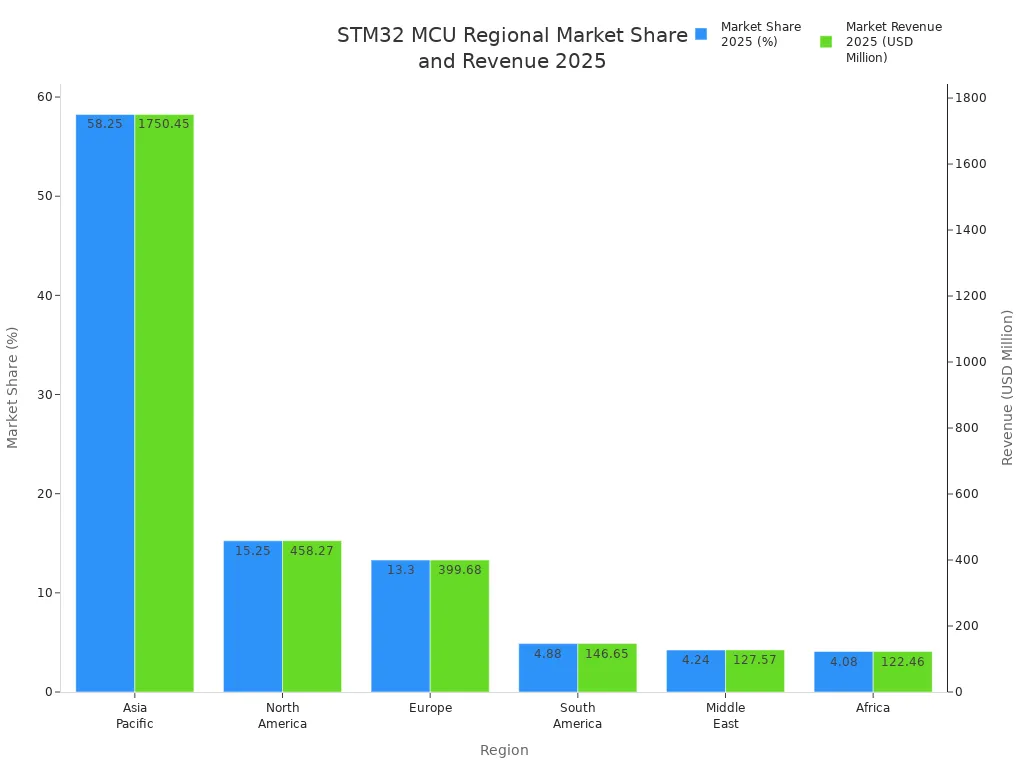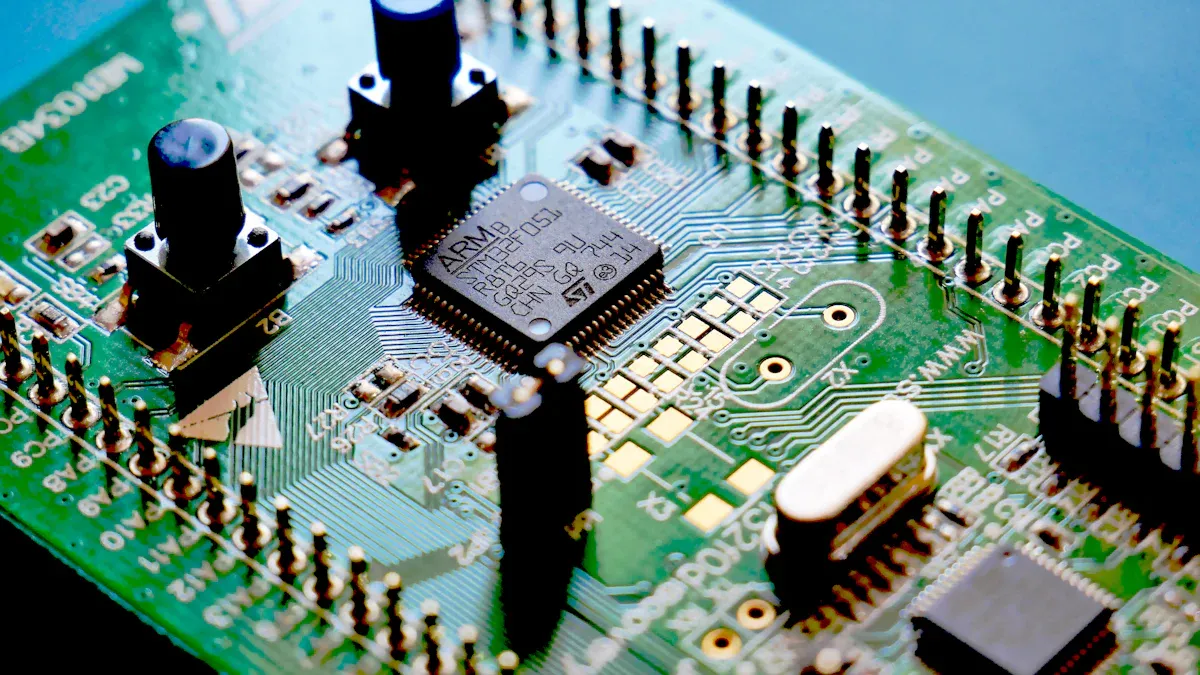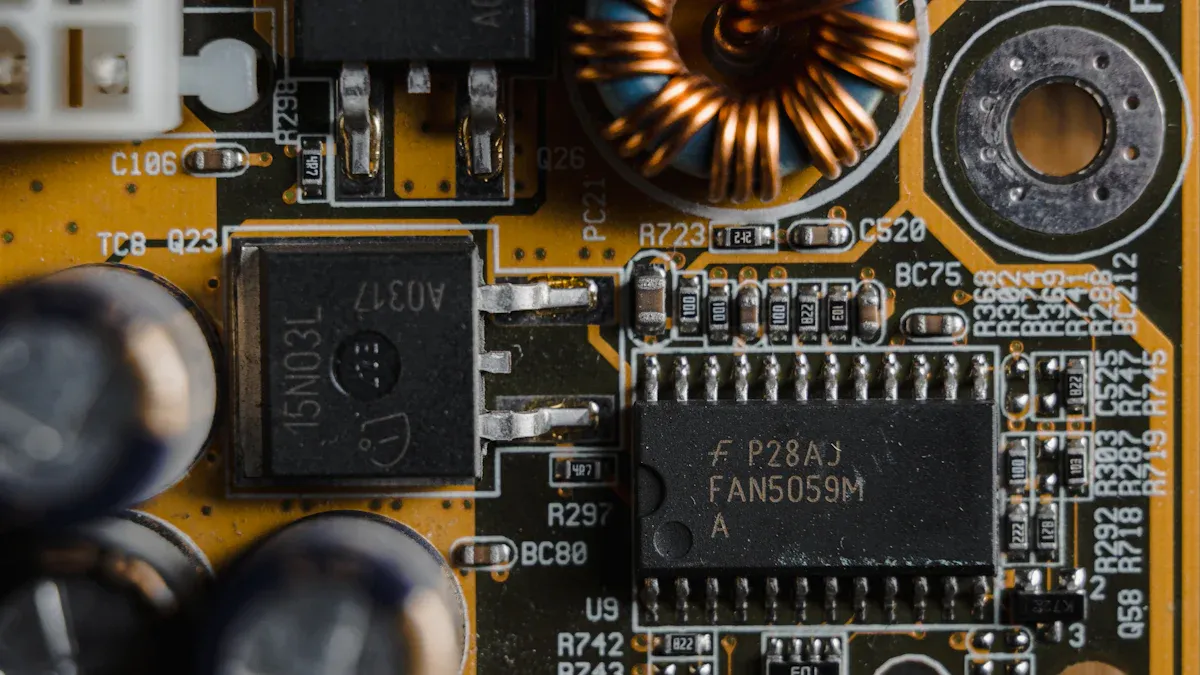What Is the STM32F405RGT6 Microcontroller and Its Main Features

The STM32F405RGT6 microcontroller uses an ARM Cortex-M4 core that runs at speeds up to 168 MHz. It supports advanced features like a floating-point unit and digital signal processing instructions. This device combines 1 MB Flash memory, 192 KB SRAM, and multiple analog and digital peripherals for complex tasks. Many engineers choose STM32 microcontrollers for their reliability and performance, especially in Asia Pacific, where they hold over half the market share.
Region | Market Share of STM32 MCUs in 2025 (%) | Market Revenue (Million USD) in 2025 |
|---|---|---|
Asia Pacific | 58.25 | 1750.45 |
North America | 15.25 | 458.27 |
Europe | 13.30 | 399.68 |
South America | 4.88 | 146.65 |
Middle East | 4.24 | 127.57 |
Africa | 4.08 | 122.46 |
Global Total | 100 | 3005.07 |

Key Takeaways
The STM32F405RGT6 uses a fast 32-bit ARM Cortex-M4 processor running up to 168 MHz, making it great for complex and real-time tasks.
It offers large memory with 1 MB Flash and 192 KB SRAM, plus backup memory to keep important data safe.
This microcontroller supports many communication options like USB, Ethernet, CAN, SPI, and I2C for easy device connections.
Power-saving modes help extend battery life, and it works well in tough environments from -40°C to 85°C.
Engineers use the STM32F405RGT6 in robotics, medical devices, industrial automation, and consumer electronics for reliable and high-performance solutions.
STM32F405RGT6 Features
Processor & Performance
The STM32F405RGT6 uses a 32-bit ARM Cortex-M4 core. This processor runs at speeds up to 168 MHz. The high clock speed allows the microcontroller to handle complex tasks quickly. The Cortex-M4 core includes a floating-point unit (FPU) for fast math calculations. It also supports digital signal processing (DSP) instructions. These features help the STM32F405RGT6 work well in real-time applications like robotics and digital audio.
The microcontroller stands out when compared to similar devices. For example, the STM32F103 uses a Cortex-M3 core and runs at only 72 MHz. The STM32F405RGT6 offers more computational power and advanced features. The adaptive real-time accelerator (ART Accelerator™) lets the processor run code from flash memory with zero wait states. This means programs run faster and more efficiently.
Note: The memory protection unit (MPU) in the STM32F405RGT6 helps keep multitasking safe and reliable.
Memory
The STM32F405RGT6 has a large amount of memory for its class. It includes 1 MB of Flash memory for storing programs and 192 KB of SRAM for data. There is also 4 KB of backup SRAM. This backup memory keeps important data safe even when the main power is off.
Memory Type | Size |
|---|---|
Flash (Program Memory) | 1 MB (1024 KB) |
SRAM (Static RAM) | 192 KB |
Backup SRAM | 4 KB |
The memory architecture uses the ART Accelerator™. This feature allows the processor to read from internal Flash memory without delays. The microcontroller also has a flexible static memory controller (FSMC). This controller lets the device connect to external memory, which is useful for applications that need more storage or faster data access.
Peripherals
The STM32F405RGT6 comes with many built-in peripherals. These help the microcontroller connect to sensors, other devices, and networks. Here are some of the key peripherals:
Three 12-bit analog-to-digital converters (ADCs) for reading analog signals.
Two 12-bit digital-to-analog converters (DACs) for generating analog outputs.
Fourteen timers and counters for measuring time and creating precise delays.
Two PWM channels for controlling motors or LEDs.
Multiple serial communication interfaces, including CAN, I2C, SPI, UART, USART, USB, and more.
Direct memory access (DMA) channels for fast data transfers.
A true random number generator for security tasks.
The microcontroller also supports advanced connectivity. It includes a USB 2.0 full-speed and high-speed controller with on-chip PHY. The Ethernet MAC peripheral supports 10/100 Mbps Ethernet with dedicated DMA and hardware timestamping. These features make the STM32F405RGT6 a strong choice for projects that need fast and reliable communication.
STM32F405RGT6 Pinout

Package
Engineers often choose microcontrollers based on their physical package. The STM32F405RGT6 comes in a Low-profile Quad Flat Package, or LQFP. This package has 64 pins and measures 10 mm by 10 mm with a height of 1.4 mm. The LQFP design helps keep the microcontroller compact, which makes it easier to fit into small devices. The flat leads on all four sides allow for easy soldering onto printed circuit boards (PCBs).
Parameter | Value |
|---|---|
Package Type | LQFP (Low-profile Quad Flat Package) |
Pin Count | 64 |
Dimensions | 10 mm x 10 mm x 1.4 mm |
Grade | Industrial |
The package type affects how engineers design the PCB. The 64-pin layout defines the footprint and spacing for each connection. Good thermal management becomes important because the flat package can spread heat across the board. The standardized shape also helps with automated assembly in factories.
Tip: The LQFP package supports both industrial and consumer electronics, making it a flexible choice for many projects.
I/O Pins
The microcontroller provides 51 general-purpose input/output (I/O) pins. These pins connect to sensors, displays, motors, and other devices. Each I/O pin can handle digital signals, and some pins support analog functions. The supply voltage for the I/O pins ranges from 1.8 V to 3.6 V, with a typical value of 3.3 V. This voltage range allows the microcontroller to work with many types of external components.
Specification | Value |
|---|---|
Package Type | 64-pin LQFP |
Total Pin Count | 64 |
Number of I/O Pins | 51 |
Supply Voltage Range | 1.8 V to 3.6 V |
Nominal Supply Voltage | 3.3 V |
I/O Pin Current Rating | N/A |
Not all pins serve as I/O. Some pins provide power, ground, or special functions like reset or clock input. Designers must check the datasheet to match each pin to its correct use. The large number of I/O pins gives engineers flexibility when connecting different modules or sensors.
Interfaces & Connectivity
Communication Protocols
Microcontrollers need to talk to other devices. The STM32F405RGT6 offers many ways to do this. Engineers can use several built-in communication protocols. These protocols help the microcontroller send and receive data with sensors, computers, or other microcontrollers.
USART (Universal Synchronous/Asynchronous Receiver/Transmitter) lets the device handle both synchronous and asynchronous serial communication.
SPI (Serial Peripheral Interface) moves data quickly between chips, such as sensors or memory.
I2C (Inter-Integrated Circuit) connects multiple devices using only two wires, making it good for simple sensor networks.
UART (Universal Asynchronous Receiver/Transmitter) provides basic serial communication, often used for debugging.
CAN (Controller Area Network) works well in cars and industrial systems, where many devices need to share information.
USB (Universal Serial Bus) allows the microcontroller to connect to computers or other USB devices.
Ethernet MAC (Media Access Controller) supports wired network connections for fast data transfer.
These options give engineers flexibility when designing systems that need to communicate with many types of hardware.
External Memory Support
Some projects need more memory than what is inside the chip. The STM32F405RGT6 includes an external memory interface. This interface can connect to extra Flash or SRAM memory. The chip’s documentation does not list exact types or sizes, but it supports several memory options.
The Flexible Static Memory Controller (FSMC) makes these connections possible. FSMC supports different memory types, such as SRAM, PSRAM, NOR Flash, NAND Flash, and even Compact Flash. It also helps connect LCD displays using parallel interfaces. FSMC allows the microcontroller to move data quickly to and from external memory. This feature helps in projects that need to store lots of data or use large displays.
FSMC improves system performance by letting the microcontroller access more memory and transfer data at high speeds.
Power & Operating Range
Power Management
The STM32F405RGT6 microcontroller uses several features to manage power efficiently. It supports three main low-power modes: Sleep, Stop, and Standby. These modes help reduce energy use when the device does not need full performance. Many engineers use these modes in battery-powered products to extend battery life.
Sleep Mode: The processor stops but keeps most functions running. This mode saves some power while allowing quick wake-up.
Stop Mode: The device turns off most clocks and keeps only essential circuits active. This mode saves more power than Sleep.
Standby Mode: The microcontroller shuts down almost everything except the backup area. This mode uses the least power.
The STM32F405RGT6 works with a supply voltage from 1.7V to 3.6V. This wide range makes it suitable for many types of power sources, including batteries. The VBAT pin powers the real-time clock (RTC) and backup memory, so the device can keep time and save important data even when the main power is off.
Other power management features include:
Power-on reset (POR) and power-down reset (PDR) to protect the chip during power changes.
Power voltage detector (PVD) and brown-out reset (BOR) to guard against low voltage.
Multiple clock sources, including a 32 kHz oscillator for low-power timekeeping.
Source Description | Operating Voltage Range | Typical Supply Voltage |
|---|---|---|
Allelcoelec Blog | 1.7V to 3.6V | 3.3V |
Jakelectronics | 1.7V to 3.6V | 3.3V |
Cirkitdesigner Docs | 1.8V to 3.6V | 3.3V |
Ariat-tech Blog | 2.0V to 3.6V | N/A |
RS Components | 1.7V to 3.6V | 1.8V to 3.6V |
Tip: Using the right power mode can help designers build products that last longer on a single battery charge.
Temperature
The STM32F405RGT6 microcontroller operates reliably in a wide range of temperatures. The recommended operating temperature spans from -40°C to 85°C. This range covers most industrial and automotive environments. Devices with this microcontroller can work in cold outdoor settings or inside hot machines.
Feature/Specification | Details |
|---|---|
Operating Temperature Range | |
RoHS Compliance | RoHS3 Compliant |
Moisture Sensitivity Level | Level 3 (168 Hours) |
Application Suitability | Industrial Control, Automotive |
This robust temperature range means the STM32F405RGT6 fits well in factory control systems, car electronics, and other demanding uses. The chip’s certifications and moisture resistance add extra reliability for tough jobs.
Applications

Use Cases
The STM32F405RGT6 microcontroller appears in many real-world products and systems. Engineers use it in both consumer and industrial devices. The table below shows some of the most common application areas and their descriptions:
Application Area | Description |
|---|---|
Consumer Electronics | Used in smart home devices and wearables for efficient processing. |
Industrial Automation | Suitable for motor control, PLCs, and automation systems. |
Provides connectivity and processing capabilities for IoT applications. | |
Medical Devices | Utilized in portable medical instrumentation for monitoring and diagnostics. |
Robotics | Employed in robotic systems for control and signal processing. |
Audio Applications | Used in digital audio processing and playback systems. |
Embedded Systems | Serves as a core component in custom embedded solutions. |
Many products rely on this microcontroller for their core functions. For example, engineers use it in motor drive and control systems, including electric vehicles and robotics. Medical instruments such as monitoring equipment and diagnostic devices also use this chip for reliable data processing. Industrial control systems, printers, scanners, alarm systems, and home audio devices benefit from its high-speed data handling and flexible interfacing.
Benefits
The STM32F405RGT6 offers several advantages for embedded system designs. Its 32-bit ARM Cortex-M4 processor runs at 168 MHz, which allows fast and efficient task execution. The microcontroller includes up to three 12-bit ADCs and two 12-bit DACs for precise analog signal processing. With 1 MB of Flash memory and 192 KB of RAM, it supports complex applications.
A wide supply voltage range (1.8V to 3.6V) and a compact 64-pin LQFP package make it suitable for many environments. The device operates reliably from -40°C to 85°C, which fits industrial and automotive needs. Engineers can use multiple communication interfaces, such as CAN, SPI, UART, and USB, to connect with other devices. Built-in security features and development tool support help speed up the design process.
The STM32F405RGT6 stands out for its balance of performance, connectivity, and reliability, making it a strong choice for demanding embedded projects.
The STM32F405RGT6 stands out for its high performance, flexible connectivity, and reliable operation. Key technical strengths include:
Feature | Description |
|---|---|
Core Architecture | ARM Cortex-M4 for efficient processing |
Clock Speed | Up to 168 MHz for fast computing |
Floating-Point Support | Handles complex math operations |
Memory | 1 MB Flash, 192 KB RAM for demanding tasks |
PWM Channels | Precise motor and device control |
Connectivity Options | USB, UART, SPI for easy interfacing |
Power Consumption | Low, ideal for battery-powered systems |
Package | Compact 64LQFP for easy integration |
Application Suitability | Used in robotics, automation, and server systems |
STMicroelectronics continues to support the STM32F4 family, ensuring long-term availability and relevance for future projects. Engineers can trust this microcontroller for high-performance and connected designs.
FAQ
What development tools support the STM32F405RGT6?
Developers can use STM32CubeIDE, Keil MDK, IAR Embedded Workbench, and Atollic TrueSTUDIO. These tools help write, debug, and upload code to the microcontroller.
Can the STM32F405RGT6 run real-time operating systems (RTOS)?
Yes, this microcontroller supports popular RTOS options like FreeRTOS and CMSIS-RTOS. These systems help manage multiple tasks and improve reliability in complex projects.
How does the STM32F405RGT6 handle security?
The STM32F405RGT6 includes a true random number generator and a memory protection unit. These features help protect data and prevent unauthorized access.
Is the STM32F405RGT6 suitable for battery-powered devices?
Yes. The microcontroller uses low-power modes such as Sleep, Stop, and Standby. These modes help save energy and extend battery life in portable products.
See Also
Best Embedded System Microcontrollers To Watch In 2025
Discover The Most Loved Features Of 32-Bit ARM MCUs
Leading Microcontrollers Supporting Ethernet And Camera In 2025
